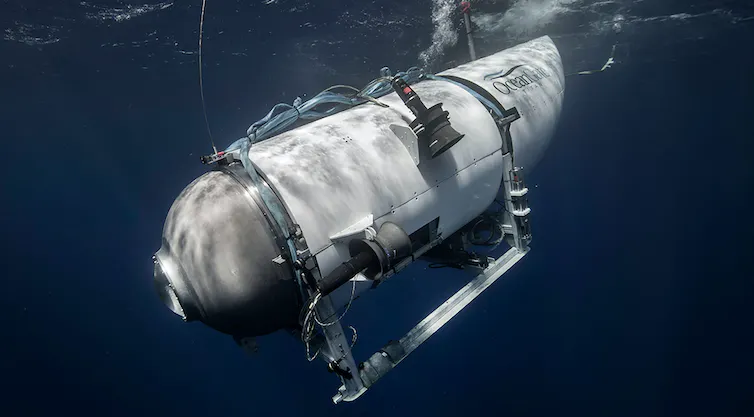
The latest on the search for the Titan submersible and outlook for rescue
June 22, 2023
By
The Associated Press

Photo: OceanGate
The search for the submersible vessel carrying five people that disappeared while on an expedition to view the wreckage of the Titanic neared the critical 96-hour mark Thursday.
A growing number of aircraft, ships and underwater equipment from the U.S., Canada and France have been searching for the Titan submersible, which was estimated to have a 96-hour supply of breathable air when it launched Sunday morning in the North Atlantic.
That means the deadline to find and rescue the sub is roughly between 6 a.m. EDT (1000 GMT) and 8 a.m. EDT (1200 GMT), based on information the U.S. Coast Guard and company behind the expedition have provided. Experts emphasized that is an imprecise estimate and could be extended if passengers have taken measures to conserve breathable air.
The small craft named Titan, owned by undersea exploration company OceanGate Expeditions, has been chronicling the Titanic’s decay and the underwater ecosystem around it via yearly voyages since 2021.
Here’s what we know so far about the submersible and what’s being done to find it:
What’s the latest on the search?
A Canadian aircraft detected underwater noises in the search area Tuesday and Wednesday, according to the U.S. Coast Guard. Officials said they don’t know what made the sounds, and a robotic vessel scouring the area so far has “yielded negative results.” Additional remotely operated vessels were sent.
“The equipment that is onsite and coming is the most sophisticated in the world and certainly capable of reaching those depths,” said Sean Leet, chief executive of Canadian company Horizon Maritime.
As of Wednesday, searchers had covered an area twice the size of Connecticut in waters 2 1/2 miles deep – the depth at which the wreck of the Titanic lies.
When and where did the Titan go missing?
The craft submerged Sunday morning, and its support vessel lost contact with it about an hour and 45 minutes later, according to the Coast Guard.
The vessel was reported overdue about 435 miles (700 kilometers) south of St. John’s, Newfoundland, according to Canada’s Joint Rescue Coordination Centre in Halifax, Nova Scotia.
The Titan was launched from an icebreaker that was hired by OceanGate and formerly operated by the Canadian Coast Guard. The ship has ferried dozens of people and the submersible craft to the North Atlantic wreck site, where the Titan has made multiple dives.
Is there any hope?
Experts say the best-case scenario would be finding the Titan on the ocean’s surface. It is equipped with safety systems to help it rise to the surface during an emergency even if everyone on board is unconscious.
If the Titan is stuck on the ocean floor, however, the occupants would eventually run out of oxygen and develop hypothermia from extreme cold. The vessel also could be caught in a fishing net or other entanglement. In those cases, the best chance to reach it could be to use a remotely operated robot on a fiber optic cable, said Jeff Karson, a professor emeritus of earth and environmental sciences at Syracuse University.
A breach of the Titan’s hull at depth would mean instant death from the heavy pressure in the deep ocean. Still, a U.S. Coast Guard official said the efforts to find the vessel remained a “search and rescue mission, 100 percent.”
Joyce Murray, Canada’s minister of Fisheries, Oceans and the Canadian Coast Guard, echoed that sentiment.
“We have to retain hope as part of what we are doing as a human community to find the explorers and bring them to safety,” she said.
A U.S. Navy official said Wednesday that a special naval salvage system that could be used to haul the Titan to the surface had arrived in St. John’s. Officials were in the process of identifying a vessel that it could be attached to, and once one is chartered, it would take about 24 hours to weld the system to the deck.